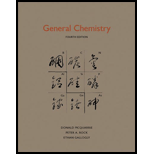
Concept explainers
(a)
Interpretation:
The vapor pressure lowering of aqueous solution that is
Concept Introduction:
Raoult’s law:
It states that the equilibrium vapor pressure of the solvent over a solution is directly proportional to the mole fraction of the solvent in the solution.
The expression for the vapor pressure lowering is given below.
Where,
(a)
Answer to Problem 16.23P
The vapor pressure lowering for the aqueous solution of sodium chloride is
Explanation of Solution
Given that the molality of aqueous solution of sodium chloride is
The number of moles of sodium chloride can be calculated as given below.
The mole fraction of sodium chloride can be calculated as given below.
The vapor pressure of water at
The vapor pressure lowering can be calculated as given below.
Therefore, the vapor pressure lowering for the aqueous solution of sodium chloride is
(b)
Interpretation:
The vapor pressure lowering of aqueous solution that is
Concept Introduction:
Refer to part (a).
(b)
Answer to Problem 16.23P
The vapor pressure lowering for the aqueous solution of calcium chloride is
Explanation of Solution
Given that the molality of aqueous solution of calcium chloride is
The number of moles of calcium chloride can be calculated as given below.
The mole fraction of calcium chloride can be calculated as given below.
The vapor pressure of water at
The vapor pressure lowering can be calculated as given below.
Therefore, the vapor pressure lowering for the aqueous solution of calcium chloride is
(c)
Interpretation:
The vapor pressure lowering of aqueous solution that is
Concept Introduction:
Refer to part (a).
(c)
Answer to Problem 16.23P
The vapor pressure lowering for the aqueous solution of sucrose is
Explanation of Solution
Given that the molality of aqueous solution of sucrose is
The number of moles of sucrose can be calculated as given below.
The mole fraction of sucrose can be calculated as given below.
The vapor pressure of water at
The vapor pressure lowering can be calculated as given below.
Therefore, the vapor pressure lowering for the aqueous solution of sucrose is
(d)
Interpretation:
The vapor pressure lowering of aqueous solution that is
Concept Introduction:
Refer to part (a).
(d)
Answer to Problem 16.23P
The vapor pressure lowering for the aqueous solution of aluminum perchlorate is
Explanation of Solution
Given that the molality of aqueous solution of aluminum perchlorate is
The number of moles oaluminum perchlorate can be calculated as given below.
The mole fraction of aluminum perchlorate can be calculated as given below.
The vapor pressure of water at
The vapor pressure lowering can be calculated as given below.
Therefore, the vapor pressure lowering for the aqueous solution of aluminum perchlorate is
Want to see more full solutions like this?
Chapter 16 Solutions
General Chemistry
 ChemistryChemistryISBN:9781305957404Author:Steven S. Zumdahl, Susan A. Zumdahl, Donald J. DeCostePublisher:Cengage Learning
ChemistryChemistryISBN:9781305957404Author:Steven S. Zumdahl, Susan A. Zumdahl, Donald J. DeCostePublisher:Cengage Learning ChemistryChemistryISBN:9781259911156Author:Raymond Chang Dr., Jason Overby ProfessorPublisher:McGraw-Hill Education
ChemistryChemistryISBN:9781259911156Author:Raymond Chang Dr., Jason Overby ProfessorPublisher:McGraw-Hill Education Principles of Instrumental AnalysisChemistryISBN:9781305577213Author:Douglas A. Skoog, F. James Holler, Stanley R. CrouchPublisher:Cengage Learning
Principles of Instrumental AnalysisChemistryISBN:9781305577213Author:Douglas A. Skoog, F. James Holler, Stanley R. CrouchPublisher:Cengage Learning Organic ChemistryChemistryISBN:9780078021558Author:Janice Gorzynski Smith Dr.Publisher:McGraw-Hill Education
Organic ChemistryChemistryISBN:9780078021558Author:Janice Gorzynski Smith Dr.Publisher:McGraw-Hill Education Chemistry: Principles and ReactionsChemistryISBN:9781305079373Author:William L. Masterton, Cecile N. HurleyPublisher:Cengage Learning
Chemistry: Principles and ReactionsChemistryISBN:9781305079373Author:William L. Masterton, Cecile N. HurleyPublisher:Cengage Learning Elementary Principles of Chemical Processes, Bind...ChemistryISBN:9781118431221Author:Richard M. Felder, Ronald W. Rousseau, Lisa G. BullardPublisher:WILEY
Elementary Principles of Chemical Processes, Bind...ChemistryISBN:9781118431221Author:Richard M. Felder, Ronald W. Rousseau, Lisa G. BullardPublisher:WILEY





